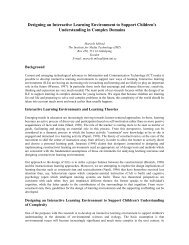Using Quality Assurance Strategies for Online Programs
Using Quality Assurance Strategies for Online Programs
Using Quality Assurance Strategies for Online Programs
Create successful ePaper yourself
Turn your PDF publications into a flip-book with our unique Google optimized e-Paper software.
faculty to develop and deliver their web-based courses in a full semestercourse with complete technical assistance. The Office of InstructionalResources (OIR) provides multimedia services to faculty. The Library andComputer Services also comprise administrative units that support onlineeducation.If your university establishes an organizational infrastructure <strong>for</strong> distanceeducation, faculty trans<strong>for</strong>ming face-to-face classroom courses into webbasedprograms should have access to support mechanisms at the university,college, and department levels. This first <strong>Quality</strong> <strong>Assurance</strong> Strategydemands then that faculty, now apprised of these available resources, takefull advantage of them. Without administrative leadership and support, theassurance of quality distance programs will likely be a daunting task.Ongoing Program Concerns and Needs<strong>Online</strong> learning requires facilitated relationships among university constituents,as well as access to the campus infrastructure and services. Universitiesmust structure web-based programs to maintain a high quality learningenvironment. Several <strong>Quality</strong> <strong>Assurance</strong> <strong>Strategies</strong> guarantee these standards.The decision to put a program online involves discussion, planning, andevaluation at several levels. The program coordinator must present a planthat clearly and comprehensively defines the online process and the onlineprogram’s direction to college and department administrators (deans, chairs,and program committees) <strong>for</strong> their support. Administrative interest pointsinclude an online delivery rationale, projected student enrollment changes,available online line support courses, a study program, recruitment strategies<strong>for</strong> program promotion, and the resources necessary <strong>for</strong> qualityassurance. The program coordinator should also present a timeline <strong>for</strong>course planning, preparation, and implementation.At the program level, needs and concerns become more specific. Programplanning and development should be based on established standards andguidelines from accrediting associations as well as national and stateprofessional organizations. Instructional designers, programmers, andtechnicians should facilitate course conversion based on academic standardsfrom a face-to-face <strong>for</strong>mat into web-based delivery. In turn, the72
















